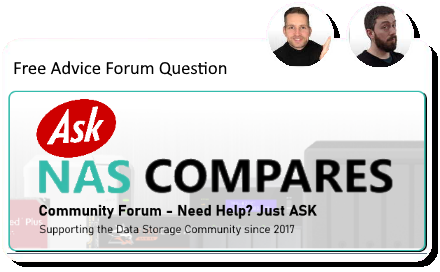09-16-2025, 09:36 AM
Thanks for reaching out, sounds like a great project. Between the UGREEN DXP4800 Plus and the Asustor Drivestor 4, I’d say they target very different audiences. The Asustor is much more of an entry-level system — quiet, affordable, but not especially powerful for creative work. The UGREEN DXP4800 Plus is newer and has stronger hardware, and while its software is still relatively young, the hardware itself makes it a much better fit for editing and heavier workflows. If you’re open to TrueNAS, then hardware like the UGREEN box gives you a better base to run it on than the Asustor would.
For drives, I’d recommend NAS-rated HDDs such as Seagate IronWolf or WD Red Plus. With four bays and creative work in mind, RAID 5 is often the right balance of capacity and protection, but if uptime is absolutely critical then RAID 6 is safer at the cost of capacity. Pairing HDDs with one or two SSDs for caching or a dedicated scratch volume can make a real difference for video and music projects.
To optimize for creative work, the main points are to make sure your network connection is fast enough (2.5GbE at a minimum, 10GbE if your workflow involves large media files), and to separate active project storage from archive. For example, keep your live editing work on SSDs and then move completed projects to HDD storage on the NAS. This avoids bottlenecks and keeps performance snappy.
As for lessons learned, the big pitfalls are underestimating how much bandwidth you need for video editing, and relying solely on RAID as your backup. Always keep at least one secondary backup of your critical projects, even if it’s just to an external drive. Also, if you do go with UGREEN, be prepared for a less polished OS compared with Synology or QNAP — updates are regular, but some features are still evolving.
If you’d like to explore TrueNAS, make sure the hardware you pick has at least 8GB RAM (16GB preferred) and enough CPU headroom, since ZFS is more resource hungry but very powerful long term.
For drives, I’d recommend NAS-rated HDDs such as Seagate IronWolf or WD Red Plus. With four bays and creative work in mind, RAID 5 is often the right balance of capacity and protection, but if uptime is absolutely critical then RAID 6 is safer at the cost of capacity. Pairing HDDs with one or two SSDs for caching or a dedicated scratch volume can make a real difference for video and music projects.
To optimize for creative work, the main points are to make sure your network connection is fast enough (2.5GbE at a minimum, 10GbE if your workflow involves large media files), and to separate active project storage from archive. For example, keep your live editing work on SSDs and then move completed projects to HDD storage on the NAS. This avoids bottlenecks and keeps performance snappy.
As for lessons learned, the big pitfalls are underestimating how much bandwidth you need for video editing, and relying solely on RAID as your backup. Always keep at least one secondary backup of your critical projects, even if it’s just to an external drive. Also, if you do go with UGREEN, be prepared for a less polished OS compared with Synology or QNAP — updates are regular, but some features are still evolving.
If you’d like to explore TrueNAS, make sure the hardware you pick has at least 8GB RAM (16GB preferred) and enough CPU headroom, since ZFS is more resource hungry but very powerful long term.





